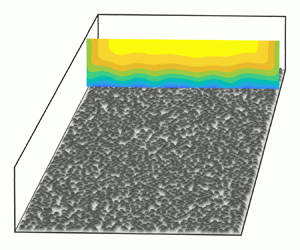Crossref Citations
This article has been cited by the following publications. This list is generated based on data provided by
Crossref.
Sarakinos, Sotirios
and
Busse, Angela
2022.
Investigation of rough-wall turbulence over barnacle roughness with increasing solidity using direct numerical simulations.
Physical Review Fluids,
Vol. 7,
Issue. 6,
Murphy, Elizabeth A. K.
Barros, Julio M.
Schultz, Michael P.
Flack, Karen A.
Steppe, Cecily N.
and
Reidenbach, Matthew A.
2022.
Boundary layer hydrodynamics of patchy biofilms.
Biofouling,
Vol. 38,
Issue. 7,
p.
696.
Mangavelli, S. C.
and
Yuan, J.
2023.
Effects of form-induced velocity in rough-wall turbulent channel flows.
Journal of Turbulence,
Vol. 24,
Issue. 1-2,
p.
14.
Ma, Haoran
Li, Yuhao
Yang, Xin
and
Ye, Lili
2023.
Data-driven prediction of the equivalent sand-grain roughness.
Scientific Reports,
Vol. 13,
Issue. 1,
Medjnoun, Takfarinas
Aguiar Ferreira, Manuel
Reinartz, Ralf
Nugroho, Bagus
Monty, Jason
Hutchins, Nicholas
and
Ganapathisubramani, Bharathram
2023.
Assessment of aerodynamic roughness parameters of turbulent boundary layers over barnacle-covered surfaces.
Experiments in Fluids,
Vol. 64,
Issue. 11,
Garg, Himani
Wang, Lei
Sahut, Guillaume
and
Fureby, Christer
2023.
Large eddy simulations of fully developed turbulent flows over additively manufactured rough surfaces.
Physics of Fluids,
Vol. 35,
Issue. 4,
Nugroho, Setyo
Nugroho, Bagus
Fusil, Eric
and
Chin, Rey
2023.
Effects of varied roughness coverage area on drag in a turbulent boundary layer using numerical simulations.
Ocean Engineering,
Vol. 287,
Issue. ,
p.
115721.
Aghaei-Jouybari, Mostafa
Yuan, Junlin
Li, Zhaorui
Brereton, Giles J.
and
Jaberi, Farhad A.
2023.
Supersonic turbulent flows over sinusoidal rough walls.
Journal of Fluid Mechanics,
Vol. 956,
Issue. ,
Chan, C.I.
and
Chin, R.C.
2023.
Turbulent boundary layer flow over a three-dimensional sinusoidal surface.
Journal of Fluid Mechanics,
Vol. 975,
Issue. ,
Ma, Guo-Zhen
Xu, Chun-Xiao
Sung, Hyung Jin
and
Huang, Wei-Xi
2023.
Secondary motions and wall-attached structures in a turbulent flow over a random rough surface.
International Journal of Heat and Fluid Flow,
Vol. 102,
Issue. ,
p.
109147.
Kaminaris, Ioannis K.
Balaras, Elias
Schultz, Michael P.
and
Volino, Ralph J.
2023.
Secondary flows in turbulent boundary layers developing over truncated cone surfaces.
Journal of Fluid Mechanics,
Vol. 961,
Issue. ,
Nair, Shyam S.
Wadhai, Vishal A.
Kunz, Robert F.
and
Yang, Xiang I.A.
2024.
Rough surfaces in underexplored surface morphology space and their implications on roughness modelling.
Journal of Fluid Mechanics,
Vol. 999,
Issue. ,
Abdelaziz, Misarah
Djenidi, L.
Ghayesh, Mergen H.
and
Chin, Rey
2024.
On predictive models for the equivalent sand grain roughness for wall-bounded turbulent flows.
Physics of Fluids,
Vol. 36,
Issue. 1,
Huang, Weichen
Wang, Kechen
Zeng, Fei
Chen, Wenbin
Zhou, Wenwu
Wen, Xin
Peng, Di
and
Liu, Yingzheng
2024.
Film Cooling Performances Under Various Upstream Roughness Conditions: Experimental Investigations and Similarity Hypothesis.
Journal of Turbomachinery,
Vol. 146,
Issue. 11,
Boldt, Ryan
McClain, Stephen T.
Kunz, Robert F.
and
Yang, Xiang
2024.
Tomographic flow measurements over additively manufactured cooling channel roughness.
Experiments in Fluids,
Vol. 65,
Issue. 4,
Huang, Weichen
Wang, Kechen
Li, Yaxiong
Chen, Wenbin
Zhou, Wenwu
Peng, Di
and
Liu, Yingzheng
2024.
Analysis of film cooling effectiveness for jet in crossflow with upstream and downstream roughness.
Physics of Fluids,
Vol. 36,
Issue. 6,
Kaminaris, Ioannis K.
and
Balaras, Elias
2024.
Direct numerical simulations of turbulent boundary layers developing over synthesised calcareous marine biofouling surfaces.
Ships and Offshore Structures,
p.
1.
Meneveau, Charles
Hutchins, Nicholas
and
Chung, Daniel
2024.
The wind-shade roughness model for turbulent wall-bounded flows.
Journal of Fluid Mechanics,
Vol. 1001,
Issue. ,
Chen, Sanmu
Zhang, Wen
Han, Jiahui
and
Wan, Minping
2024.
Energy transfer in compressible channel flows with two-dimensional sinusoidal rough walls.
Physics of Fluids,
Vol. 36,
Issue. 4,
Shin, Heesoo
Khorasani, Seyed Morteza Habibi
Shi, Zhaoyu
Yang, Jiasheng
Bagheri, Shervin
and
Lee, Sangseung
2024.
Data-driven discovery of drag-inducing elements on a rough surface through convolutional neural networks.
Physics of Fluids,
Vol. 36,
Issue. 9,



